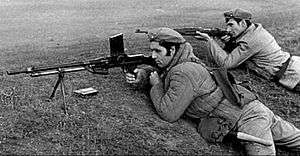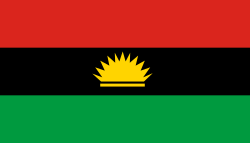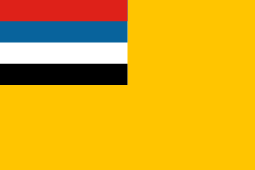ZB vz. 30
The ZB-30 and ZB-30J were Czechoslovakian light machine guns that saw extensive use during World War II.
| Vz. 30 | |
|---|---|
 Yugoslav-made ZB vz. 30 | |
| Type | Light machine gun |
| Place of origin | Czechoslovakia |
| Service history | |
| In service | 1930–2009[1] |
| Used by | See Users |
| Wars | Chaco War[2] Second Italo-Ethiopian War[3] Spanish Civil War[4] World War II First Indochina War Algerian War Biafran war War in Afghanistan (2001–present)[1] |
| Production history | |
| Designed | 1930 |
| Manufacturer | Zbrojovka Brno, Military Technical Institute Kragujevac[5] |
| Specifications | |
| Mass | 9.10 kg (20.06 lb) |
| Length | 1,180 mm (46.5 in) |
| Cartridge | 7.92×57mm Mauser |
| Action | Gas-operated, tilting breechblock |
| Rate of fire | 550-650 rounds/min |
| Muzzle velocity | 750 m/s (2,461 ft/s) |
| Effective firing range | 1,000 m (1,100 yd) |
| Feed system | 20-round detachable box magazine |
| Sights | Front blade, rear leaf sight |
History
The Zb 30 and Zb 30J were the later versions of the famous Czechoslovak machine gun, the ZB-26. However, the ZB-30 had some design differences, making it similar to the later ZGB-33, which was an early prototype of the Bren gun.[6] Like the ZB-26, the Wehrmacht adopted the ZB-30 after the occupation of Czechoslovakia, renaming it the MG30(t); it was used in the same role as the MG34, as a light machine gun. In the opening phases of World War II, the ZB-30 in 7.92 mm Mauser caliber was used in large numbers by elements of the German Waffen SS, who did not initially have full access to standard Wehrmacht supply channels.[1]
Comparison of original ZB vz.26 and modifications:
| Machine gun | ZB vz.26 | ZB vz.30 | ZB vz.30J |
|---|---|---|---|
| Caliber (mm) | 7.92 | 7.92 | 7.92 |
| Length (mm) | 1165 | 1180 | 1204 |
| Weight (kg) | 8.84 | 9.10 | 9.58 |
| Magazine (rounds) | 20 | 20 | 20 |
| Rate (round/min) | 500 | 550-650 | 500-600 |
| Velocity (m/s) | 750 | 750 | 750 |
Users

.svg.png)








.svg.png)

.svg.png)
.svg.png)





.svg.png)




.svg.png)
References
- Grant 2013, p. 65.
- Alejandro de Quesada (20 November 2011). The Chaco War 1932-35: South America's greatest modern conflict. Osprey Publishing. p. 24. ISBN 978-1-84908-901-2.
- "ZB VZ 30". iwm.org.uk. Imperial War Museum.
- de Quesada, Alejandro (20 Jan 2015). The Spanish Civil War 1936–39 (2): Republican Forces. Men-at-Arms 498. Osprey Publishing. p. 38. ISBN 9781782007852.
- http://www.zastava-arms.rs/sr/imagetext/1919-1941
- Modern Firearms - ZB 26
- Fencl, Jiří (1991). "Nejprodávanější československá zbraň" (in Czech). Militaria, Elka Press. Retrieved 12 March 2019.
- "StG-44 in Africa after WWII". wwiiafterwwii.wordpress.com. 27 September 2015.
- Jowett, Philip (2016). Modern African Wars (5): The Nigerian-Biafran War 1967-70. Oxford: Osprey Publishing Press. p. 22. ISBN 978-1472816092.
- Grant 2013, p. 10.
- Jowett, Philip S. (1997). Chinese Civil War Armies 1911-49. Men at Arms 306. Osprey Publishing. p. 36. ISBN 1855326655. Retrieved April 24, 2014.CS1 maint: ref=harv (link)
- Perutka, Lukáš (September 2014). Checoslovaquia, Guatemala y México en el Período de la Revolución Guatemalteca: Ibero-Americana Pragensia - Supplementum 32/2013 (in Spanish). Karolinum Press. p. 36. ISBN 978-80-246-2429-7.
- "Fusils-mitrailleurs Lehky Kulomet ZB vz.26 and vz.30". Encyclopédie des armes : Les forces armées du monde (in French). II. Atlas. 1984. p. 262.
- Smith 1969, p. 463.
- Smith 1969, p. 498.
- Jowett, Philip S. (2010). Rays of the rising sun : armed forces of Japan's Asian allies, 1931-45. 1, China & Manchukuo. Helion. p. 15. ISBN 9781906033781.
- Smith 1969, p. 535.
- Mark Axworthy, London: Arms and Armour, 1995, Third Axis, Fourth Ally: Romanian Armed Forces in the European War, 1941–1945, p. 29
- John Walter, Greenhill Books, 2004, Guns of the Third Reich, p. 86
- Mark Axworthy, London: Arms and Armour, 1995, Third Axis, Fourth Ally: Romanian Armed Forces in the European War, 1941–1945, p. 75
- "Fusil Ametrallador Oviedo (FAO): otro capítulo más de nuestra gloriosa historia armera". arma.es (in Spanish). 24 March 2017.
- Windrow, Martin (20 Sep 2018). French Foreign Légionnaire vs Viet Minh Insurgent: North Vietnam 1948–52. Combat 36. Osprey Publishing. pp. 24–25. ISBN 9781472828910.
- http://www.zastava-arms.rs/en/imagetext/1919-1941
- Smith 1969, p. 320.
- McNab, Chris: Twentieth-century Small Arms, Grange Books, 2004; ISBN 1-84013-381-3
- Grant, Neil (2013). The Bren Gun. Weapon 22. Osprey Publishing. ISBN 978-1782000822.
- Smith, Joseph E. (1969). Small Arms of the World (11 ed.). Harrisburg, Pennsylvania: The Stackpole Company.CS1 maint: ref=harv (link)